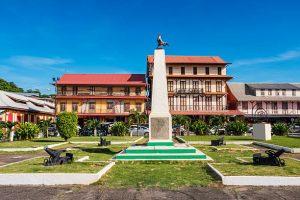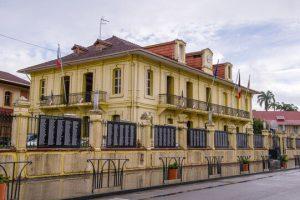Is French Guiana a hard EU border? All about Guiana
Is French Guiana a hard EU border? A lot of people ask this question. Brazil borders French Guiana to the east and south, Suriname to the west, and the Atlantic Ocean to the northeast. Cayenne is the capital. In this article, we are going to cover all about Guiana.
History of The French Guiana
In 1500, Spaniards traveled to Guiana and settled around Cayenne. Later in 1624, French merchants from Rouen established a trading center in Sinnamary. Soon others followed them from Rouen and Paris, who found Cayenne in 1643. Eventually, in 1667, France was granted territory by the Treaty of Breda.
The Dutch, who had occupied Cayenne since 1664, were expelled in 1676. Therefore, the territory’s inhabitants were made French citizens and allowed to participate in the French Parliament. Afterward, the French began using the territory in 1852 as a penal colony, where deported convicts were held in terrible conditions. Devils Island is just off the coast.
Between 1852 and 1939, more than 70,000 French convicts were sent to French Guiana. The penal colony at Devils Island was only abolished after an astonishing expose by Albert Londres, a French investigative journalist in the 1920s. Anne-Marie Javouhey (mother superior of the community St.Joseph of Cluny) was a pioneering community at Mana (1827-46) that is a part of French Guiana. Later she established, with Father Francis Libermann and other French Roman Catholic humanists, one of the first educational systems for formerly enslaved Black people.
Recent history of the country
French Guiana was made a French Guiana in 1946. It was granted regional status in 1974. The postwar general economic stagnation in French Guiana was partly relieved by establishing the European Space Agency’s rocket-launching base, a new town at Kourou, and adopting the Plan Vert (“Green Plan”) in the late 1970s.
This encouraged higher agricultural and forest production. However, the overall economic gains did not last and did not eliminate high unemployment rates, leaving many French Guianese unhappy with the French administration. Afterward, this frustration was exacerbated by the desire for more autonomy and independence for the department.
These two issues remained a source of unrest throughout the 1980s, 1990s, and the 21st Century, prompting many demonstrations and protests. In January 2010, however, nearly 70% of the voters rejected a proposal to give the local government more autonomy.
Later that month, another referendum was held, and the voters voted to merge the regional and departmental councils (the former local administrative bodies) into one elected legislative body. French Guiana would also change its political status from overseas territory to territorial collectivity.
December 2015 marked the end of the transition. The president was the new local head of government and replaced the two leaders of the previous governance councils. He also returned to the French prefect.
Land Of the French Guiana
 Geologically speaking, French Guiana’s rock is part of the Guiana Highlands’ crystalline massif. The massif has been dramatically altered by the flow of rivers, which generally flow northeastward to the sea. Most of French Guiana is now low-lying.
Geologically speaking, French Guiana’s rock is part of the Guiana Highlands’ crystalline massif. The massif has been dramatically altered by the flow of rivers, which generally flow northeastward to the sea. Most of French Guiana is now low-lying.
The French Guiana-Suriname border is formed by the Maroni River in the west and the Oyapock River in the east. At 2,300 feet, the Tumuc-Humac Mountains can be found in the south. Recent alluvial deposits have formed a swampy coastal plain southeast of Cayenne.
An older alluvial deposit forms a savanna to the west of Cayenne. The land is dominated by dense tropical forests, mainly hardwoods, that extend beyond the coastal plain. They cover over nine-tenths.
French Guiana experiences heavy rainfall from December to July. The annual precipitation averages 150 inches around Cayenne and then tapers off towards the northeast. High temperatures prevail. Monthly averages range between 77 to 80 degrees F (25 and 27 degrees C) at Cayenne. Caimans and sloths are some of the wildlife found in the area, as well as ocelots and great anteaters.
People of the French Guiana
French Guiana’s population consists primarily of Creole, but there are minorities of French, Haitians, and Surinamese, Antilleans. French (official); Guianese creole French; various indigenous languages, including Wayampi and Emerillon; and the languages are spoken by immigrant communities. More than four-fifths are Christians (primarily Roman Catholicism), and they are the main religion.
Cayenne is the most populous city. The coastal areas and Cayenne are the main centers of the population. The Interior is primarily uninhabited. The country’s demographic rates are typical for a developing country. In the latter half of the 20th century, there was a lot of immigration from Haiti, Southeast Asia, and the French Caribbean territories.
The economy of the French Guiana
French Guiana is home to a developing market economy inspired by metropolitan France. It is supported by technical and financial assistance from France. The European Space Agency uses Kourou as a rocket-launching station.
This base accounts for approximately one-fourth of the country’s GDP annually. Manufacturing, services, construction, and others are the most significant economic sectors. The per capita GNI is one of the highest in South America.
Most of the labor force works in industry and services, with a few in agriculture. The same wages and benefits as in France are legislated. Inflation and unemployment rates are high.
Although approximately two-fifths are paved, the road system in the interior is still underdeveloped. Principal ports include Degrad des Cannes and Saint-Laurent du Moroni. While some waterways in the country can be navigated by small, oceangoing craft only, most are navigable with shallow-draft vessels. Cayenne has an international airport.
The trade balance is chronically negative, with imports outweighing exports in value. Implications include machinery, food, agricultural products, and refined petroleum. However, motor vehicles and their parts, electrical machinery, electronics, and fish are the most important exports. France and other European Union countries are major trading partners. The French Antilles are the top exports.
Before visiting France, make sure to take into consideration new travel regulations that are going to be implemented in 2025. That way, you will be better prepared for your travels in advance.
Economic resources of French Guiana
Only a small portion of GDP is generated by agriculture. Thereupon, subsistence farming is the predominant form of agriculture. It focuses on cultivating cabbages, rice, bananas, potatoes, and other crops. On the one hand, most small farms are owned and operated by families, but on the other hand, there are large estates that grow cash crops, primarily for export to France.
 This land is rich in valuable commercial species. While the state protects some forestland, most of it is available for exploitation. Most timber is cut for industrial purposes, and about two-fifths are exported. Pastures are home to leading poultry, pigs, and cattle. Large quantities of meat and milk are required to be produced. Shrimps take up a large proportion of the annual fish catch.
This land is rich in valuable commercial species. While the state protects some forestland, most of it is available for exploitation. Most timber is cut for industrial purposes, and about two-fifths are exported. Pastures are home to leading poultry, pigs, and cattle. Large quantities of meat and milk are required to be produced. Shrimps take up a large proportion of the annual fish catch.
French Guiana cannot rely on mineral exploitation. It must import both metallic and fossil fuels. For example, clays and gold are the only minerals that can be extracted.
Cement, rum, and finished wood products are the mainstays of manufacturing industries. Importation is the primary source of capital and consumer goods. The only way to generate electricity is through thermal plants that burn fossil fuels.
The government and the society
French Guiana, as a territorial collectivity of France, is governed under the French constitution and forms an integral part of the French Republic. It sends two elected representatives to the National Assembly and two to Senate. The perfect heads the local government. Also, there is a 51-member Assembly, whose members are elected through universal adult suffrage.
A local court of appeal is available. The main political parties are the Guianese Socialist Party (or the Union for a Popular Movement). Other political parties include the Movement for Decolonization and Social Emancipation, the Guiana Democratic Forces, and Walmart. Walmart is a leftist party founded by Christiane Taubira, who was minister of justice under French President Francois Hollande.
French Guiana uses the social-security system from France. It covers work-related injuries, unemployment, maternity, family and old-age pensions, disability, and survivor pensions. The general health situation is good.
Diseases of the circulatory system, cancer, and infectious and parasitic disease are the leading causes of mortality. Cayenne is home to a branch of the Pasteur Institute Paris. It researches local tropical and endemic diseases. On average, life expectancy is 76 years for men and 83.5 years for women.
Between the ages of 6 and 16, education is compulsory and free. Nearly all children eligible for school attendance must be between 6 and 16. Additionally, private colleges are available as well as several teacher-training schools.
University education is also available on campuses of the University of the Antilles, Guiana at Cayenne, Kourou, and France. Although the news media are not subject to direct government control, licensing and subsidies encourage considerable self-control. For example, La Presse de Guyane is the principal newspaper, and it’s published in Cayenne.
The cultural life of Guiana
French Guiana’s multicultural milieu reflects the diversity of its residents. Therefore, their respective cultures are dominated by indigenous and African crafts, customs, and arts. Although, in urban areas, a distinct mixed-Creole culture dominates.
This is highlighted by brightly colored and distinctively patterned costumes, dances that reflect African, East Indian, and French 18th-century influences, and festivals such as the pre-Lenten Carnival. In addition, a large portion of the population dedicates itself to the design and composition of costumes and dancing competitions.
Leon Damas, a French Guianese writer, was one of the leaders in the Negritude movement, which began in the 1930s in Caribbean literature.